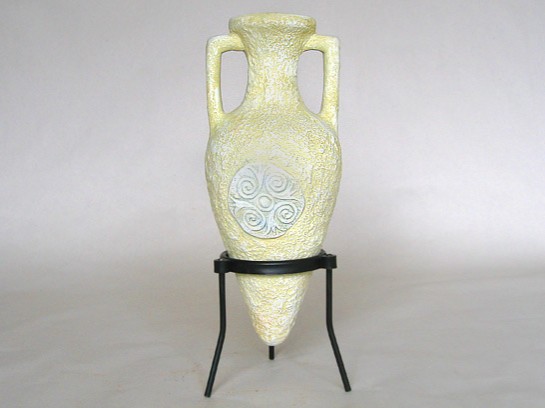An amphorais a type of ceramic vase with two handles and a long neck narrower than the body.
Amphorae first appeared on the Lebanese-Syrian coast around the 15th century BC and spread around the ancient world, being used by the ancient Greeks and Romans as the principal means for transporting and storing, grapes, olive oil, wine, oil, olives, grain, fish, and other commodities. They were produced on an industrial scale from Greek times and used around the Mediterranean until about the 7th century. Wooden and skin containers seem to have supplanted amphorae thereafter.
They are of great benefit to maritime archaeologists, as amphorae in a shipwreck can often indicate the age and nationality of the wreck. They are occasionally so well preserved that the original contents are still present, providing invaluable information on the eating habits and trading systems of the ancient Mediterranean peoples.
Two principal types of amphora existed: the neck amphora, in which the neck and body meet at a sharp angle; and the one-piece amphora, in which the neck and body form a continuous curve. Neck amphorae were commonly used in the early history of ancient Greece but were gradually replaced by the one-piece type from around the 7th century BC onwards. Most were produced with a pointed base to allow them to be stored in an upright position by being partly embedded in sand or soft ground.
Amphorae varied greatly in height. The largest could stand as much as 1.5 m (5 ft) high, while some were under 30 cm (12 inches) high - the smallest were called amphoriskoi (literally "little amphorae"). Most were around 45 cm (18 inches) high. There was a significant degree of standardisation in some variants; the wine amphora held a standard measure of about 39 litres (41 quarts), giving rise to the amphora quadrantal as a unit of measure in the Roman Empire. In all, around 66 distinct types of amphora have been identified.
High-quality painted amphorae were produced in significant numbers for a variety of social and ceremonial purposes. Their design differs significantly from the more functional versions; they are typified by wide mouth and a ring base, with a glazed surface and decorated with figures or geometric shapes. Such amphorae were often used as prizes. Some examples, bearing the inscription "I am one of the prizes from Athens", have survived from the Panathenaic Festivals held between the 6th century BC to the 2nd century BC. Painted amphorae were also used for funerary purposes. The loutrophoros, a type of amphora, was used principally for funeral rites. Outsize vases were also used as grave markers, while some amphorae were used as containers for the ashes of the dead.
The word amphora is Latin, derived from the Greek amphoreus (Αμφορέας) or amphiphoreus, a compound word combining amphi- ("on both sides") plus phoreus ("carrier"), from pherein ("to carry").
Product Details
Code: 016A
Dimensions: 10x20cm
Colors: White, Black, Brown
